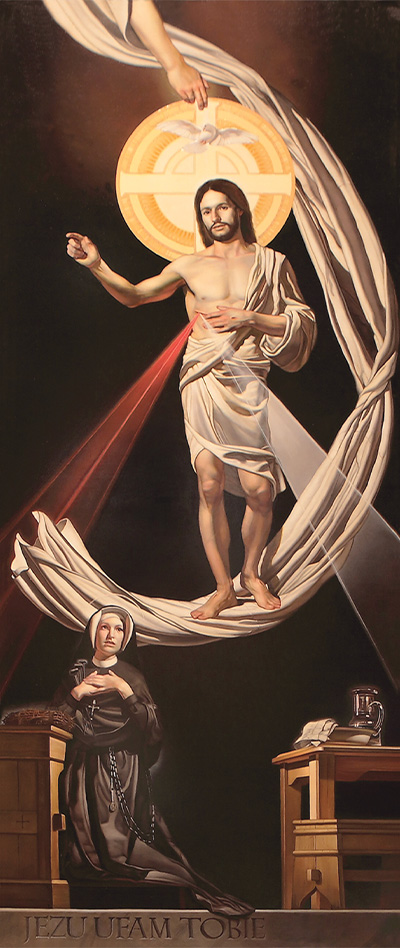Painting: Saint Faustina & Divine Mercy
“Helen Kowalska was born in Poland in 1905. She would one day become ‘Saint Faustina’ when canonized in the year 2000, by Pope John Paul II.”
While alone in her cell, one February day in 1931, the apparition of Christ appeared to Sr. Faustina. Christ raised one hand in blessing while the other hand touched his chest where two rays of light shone forth; 1 red ray of light and the other a white ray of light. The light rays symbolized both blood and water: The Blood of Christ, which nourishes the soul, and the Water, which cleanses the soul.
At that moment, Jesus dictated a prayer for Sr. Faustina to record and recite, which became known as the Chaplet of Divine Mercy. The goal of the chaplet is to: obtain mercy, to trust in Christ’s mercy, and to show mercy to others. Additionally, Christ emphasized His love of mankind and His commitment to the forgiveness of the soul who has turned away from God, should they ask for His mercy.
Jesus implored Sr. Faustina to have the image of Divine Mercy painted, which she did, though she was never satisfied with the artist’s work.
Side-Aisle Painting in Shrine Church
“During her life, Sr. Faustina recorded in her journal that she received the Stigmata, though she never disclosed how or where she received the wound. Thus, St. Faustina is depicted with the Instruments of Passion: crown of thorns and nails to symbolize her stigmata.
In keeping with the tradition of Divine Mercy imagery, the phrase ‘Jesus, I Trust in You‘ is added to the painting. To honor St. Faustina’s Polish heritage, the phrase has been translated into Polish, ‘Jesu, Ufam Tobie‘.
For added poignance, included in this Divine Mercy image is the Trinity: The Father (the Hand of God), The Son (Christ) and the Holy Spirit (dove).
My depiction of Jesus in this work is that of the Resurrected Christ: He stands upon His burial shroud from the tomb, His wounds are clean and have ceased bleeding.
Divine Mercy has a strong connection with Easter, as Divine Mercy Sunday falls on the Sunday immediately after Easter Sunday. The Divine Mercy Novena is a special prayer which is recited during the 9 days between Good Friday and Divine Mercy Sunday.”
— Noah Buchanan, artist
